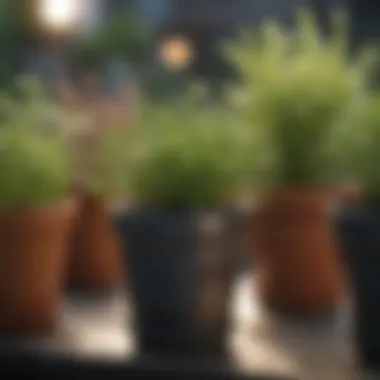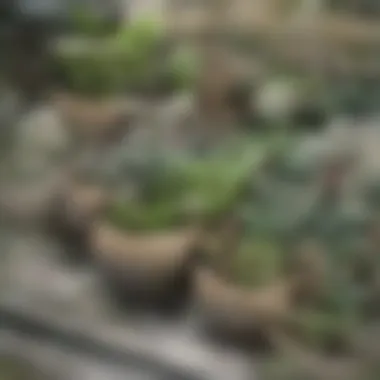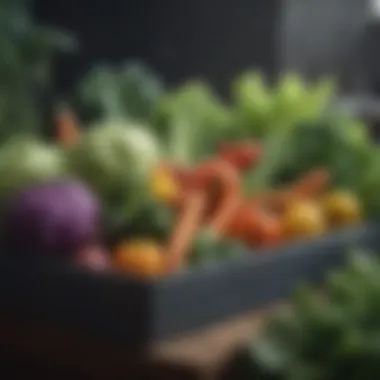Optimizing Container Gardening: Best Vegetables for Pots


Intro
Container gardening offers a unique opportunity for those with limited space to cultivate fresh vegetables. Many people live in environments that do not allow for traditional gardening. However, with the right planning and knowledge, growing vegetables in pots can become not only a possibility but a rewarding experience. This article will provide insights on selecting the best vegetables for pots, focusing on growth patterns and care requirements.
By understanding the adaptability and ease of growth of various vegetables, gardeners can maximize their yields even in small or urban settings. This guide aims to illustrate practical strategies to choose suitable vegetables, enabling homeowners to embrace sustainable gardening practices. The following sections will delve into specific vegetables, their requirements, and tips to optimize your container gardening experience.
Choosing the Right Vegetables for Pots
Not all vegetables are suitable for growth in containers. Some require more space than traditional pots can provide. Thus, selecting the most appropriate vegetables is crucial. Here are some popular choices:
- Tomatoes: These are often considered the best vegetables for containers. They thrive in pots when given adequate sunlight and support for growth.
- Peppers: Bell peppers and hot peppers grow well in smaller spaces. They need sunlight and frequent watering to produce a high yield.
- Lettuce: An excellent option for quick harvests, lettuce can even be grown in shallow containers.
- Radishes: Fast-growing and requiring little depth, radishes are perfect for those who want quick results.
- Herbs: Technically not vegetables, but culinary herbs like basil and parsley are easy to grow and enhance any garden.
Factors to Consider
When determining which vegetables to grow, consider the following factors:
- Space: Assess the size of your pots and balcony or patio area. Some vegetables require more space.
- Climate: Different vegetables have varying tolerance to temperature and weather. Choose vegetables that thrive in your local climate.
- Sunlight: Most vegetables flourish with at least six hours of sunlight each day. Ensure your space can accommodate such needs.
Gardening is an act of hope. By choosing the right vegetables, you're not just planting seeds but fostering resilience and sustainability in your urban environment.
Care Requirements
In addition to choosing the right vegetables, paying attention to their care is vital.
- Watering: Container plants often need more frequent watering as pots can dry out quickly.
- Fertilization: Use quality potting soil and consider regular feeding with organic fertilizers.
- Pest Management: Monitor plants for pests and act early to manage them.
By following these care guidelines, gardeners can ensure their vegetable plants flourish, leading to a bountiful harvest, even in limited spaces.
Epilogue
Container gardening presents an incredible possibility for maximizing yields in urban settings. By choosing the right vegetables, understanding their requirements, and providing optimal care, anyone can enjoy the fruits of their labor from small spaces. As cities continue to grow, sustainable gardening practices become increasingly important. Embrace the world of container gardening and witness the transformation of limited space into a thriving vegetable garden.
Understanding Container Gardening
Container gardening is a significant approach for anyone wanting to grow vegetables, especially in limited spaces. This section emphasizes the fundamental aspects that any aspiring gardener should grasp before starting.
Definition of Container Gardening
Container gardening refers to the practice of growing plants in containers instead of traditional in-ground methods. This method allows for great flexibility in choosing where to plant. Whether on a balcony, patio, or even indoors, using containers enables gardeners to cultivate vegetables in locations that would otherwise be unsuitable. Understanding this definition lays the foundation for discovering the potential of container setups.
Benefits of Growing Vegetables in Pots
Growing vegetables in pots provides many advantages. First and foremost, it allows gardeners to manage soil quality better. The soil can be tailored specifically for each plant type, which aids in maximizing growth and yield. Furthermore, containers can be moved easily to capture the best sunlight throughout the year. This flexibility cannot be underestimated, especially for those in urban areas with varying conditions. Lastly, container gardening promotes efficient use of space, making it ideal for those with limited outdoor areas.
Factors to Consider in Container Gardening
When engaging in container gardening, several factors can impact your success.
Space Availability
Space availability is critical for establishing a thriving container garden. For those living in apartments or homes with small yards, it can often dictate your planting options. It highlights the need to select plants that can fit comfortably within the constraints of the available area. However, even a small balcony can support a variety of vegetables if planned correctly. Ultimately, maximizing limited space can lead to a productive garden.
Light Requirements
Light requirements represent another key consideration when choosing vegetables for pots. Different plants have varying light needs, often categorized as full sun, partial shade, or shade. For example, tomatoes require full sunlight, while certain leafy greens can thrive with less. Understanding these requirements helps in arranging pots to cater to each plant's needs. By managing light optimally, your container garden can flourish.
Climate Considerations
Climate considerations play a significant role in the success of container gardening. Every plant has preferred temperature and humidity levels. Knowing your climate zone helps in selecting vegetables that can thrive in your area. Certain vegetables can withstand cooler temperatures, while others may not be as resilient during hot spells. By factoring in climate, one can choose plants that will not only survive but also yield effectively throughout the growing seasons.
Essential Container Gardening Supplies
Container gardening requires careful selection of supplies that optimize plant growth and ensure sustainability in a limited space. The right choices can make a significant impact on your gardening success. Understanding what you need will help you achieve a fruitful harvest while maintaining plant health.
Selecting the Right Pot
Material Types
Choosing the right pot material is crucial because it influences drainage, insulation, and aesthetics. Common materials include plastic, ceramic, terracotta, and metal.


- Plastic pots are lightweight and retain moisture well, making them quite popular among indoor and outdoor gardeners. They are easy to move and come in various colors and styles. However, they may not provide the best insulation for plant roots in extreme temperatures.
- Ceramic pots often have an attractive finish and remain stable in the sun. They are heavy, which can help prevent tipping over. Yet, they can be prone to cracking if exposed to freezing temperatures.
- Terracotta offers excellent breathability. This material allows moisture to evaporate and prevents over-watering, which is crucial for many vegetables. However, they dry out quickly, requiring more frequent watering.
- Metal pots are sturdy and can add a modern touch to your garden. They conduct heat well, which can benefit heat-tolerant plants. But they may cause soil temperatures to rise too high in hot weather.
Each material has distinct advantages and disadvantages. How you choose will depend on your climate, the types of vegetables you plan to grow, and personal aesthetic preference.
Size Considerations
Pot size plays a significant role in the health of your plants. Vegetables require adequate space for root growth. The key characteristic of pot size is its depth and diameter, both of which affect root development.
- A minimum diameter of 12 inches is often recommended for most vegetables, providing enough room for roots to expand. Larger pots also help retain moisture, reducing the frequency of watering.
- Depth is another consideration. For instance, root vegetables like carrots need deep pots to thrive, while leafy greens may be content in shallower containers.
Planning ahead with the right pot size can prevent problems associated with overcrowding and root stress. A pot that is too small will limit your plants’ ability to absorb nutrients and water, ultimately hindering their growth.
Choosing the Appropriate Soil
Soil is the lifeblood of your container garden. Choosing the right soil ensures that plants receive adequate nutrients and proper drainage.
Soil Composition
The essence of soil composition lies in its components. Good potting soil should contain a mix of peat moss, vermiculite, or perlite to ensure the proper balance of moisture retention and drainage.
- Peat moss provides essential nutrients and moisture. However, it decomposes over time, necessitating eventual replacement.
- Vermiculite and perlite enhance aeration in the soil, preventing compaction that can suffocate plant roots.
A well-balanced soil composition encourages healthy growth and supports the nutrient needs of various vegetables. Plants in inadequately prepared soil often show signs of distress, such as yellowing leaves and stunted growth, indicating a need for better soil selection.
Drainage Needs
Proper drainage is essential in container gardening. Without it, excess water can lead to root rot and other issues that can compromise plant health.
- Containers should have drainage holes in the bottom to allow water to exit and prevent waterlogged soil. Choosing a pot with good drainage can effectively combat common gardening challenges.
- Additionally, placing a layer of gravel or broken pottery at the bottom can enhance drainage. It keeps the soil elevated, allowing excess water to escape while preventing soil from clogging the holes.
Ensuring adequate drainage can improve the vitality of your plants while minimizing maintenance effort.
Watering Tools and Techniques
Effective watering is vital for nurturing your container garden. The right tools and techniques can make watering efficient and practical.
- Watering cans with a narrow spout allow for precise control over where water goes.
- Soaker hoses or drip irrigation systems can automate watering, reducing the need for constant monitoring.
Experimenting with these tools will help you develop a routine that meets the needs of your vegetables without excess stress on your part.
In container gardening, remember that the health of your plants often starts with the right supplies. Invest time in selecting the appropriate pots, soil, and watering tools for a successful gardening experience.
Vegetables That Thrive in Pots
The choice of vegetables that thrive in pots is crucial for optimizing container gardening. Not all plants adapt well to container life, so understanding which vegetables can flourish in limited space is essential. This section presents specific types of vegetables suited for pots, focusing on growth pattern, care requirements, and yield potential. The selected vegetables not only maximize the use of space but also encourage sustainable growing practices.
Leafy Greens
Leafy greens are often the first choice for those starting with container gardening. They grow quickly and can be harvested in various stages, making them an agile option for small spaces.
Lettuce Varieties
Lettuce varieties, including butterhead and romaine, are particularly well-suited for pots. The key characteristic of these lettuces is their fast growth, which allows gardeners to see results in a short time. This quick turnover can be very satisfying for beginners. An advantage of lettuce in pots is the option for successive planting, which ensures a continuous harvest. However, these plants are sensitive to heat, requiring careful attention to temperature and light.
Spinach
Spinach is another excellent choice for pot cultivation. Its key characteristic is the ability to grow well in partial shade, making it ideal for less sunny spots. Spinach can be harvested multiple times, allowing for a prolonged growing season. The unique feature of spinach is its nutritional density, providing significant health benefits. One disadvantage to consider is its susceptibility to bolting when temperatures rise, which can affect yield.
Kale
Kale stands out as a nutritious leafy green that can withstand cooler temperatures. This plant's robustness is its defining trait, allowing it to thrive in a variety of conditions. Kale remains productive for months, especially when grown in the fall and early winter. Its ability to adapt to different pot sizes is a practical advantage. However, it may attract pests, so regular monitoring is necessary.
Root Vegetables
Root vegetables offer diversity and are invaluable for small gardens. Their underground growth allows for an efficient use of space, making them ideal for containers.
Radishes
Radishes are particularly quick to grow, with a life cycle of around 30 days. Their notable characteristic is that they can be planted closely together in containers. This allows for multiple harvests in minimal space. Radishes also help to break up the soil in pots, improving growing conditions for future plantings. The main disadvantage is that they are picky about watering; inconsistent moisture can lead to poor development.
Carrots


Carrots thrive in deeper pots, allowing their roots to grow properly. Their vibrant color and sweetness are their key features, making them a popular choice among gardeners. Carrots can be harvested at various sizes, catering to different culinary needs. One unique aspect is the variety in color and taste that carrots offer. However, they require patience, as they take longer to develop compared to radishes.
Beets
Beets are known for their adaptability to container growth. Their unique feature is dual harvestability; both the roots and greens can be enjoyed. This characteristic maximizes the use of space and provides versatility in the kitchen. Beets thrive in cooler weather, making them a great fall crop. On the downside, they prefer rich soil, requiring careful consideration during potting to ensure nutrient availability.
Fruiting Vegetables
Fruiting vegetables can be very rewarding in pot gardening. They often require more space, but their yield can be substantial.
Tomatoes
Tomatoes are among the most popular fruiting vegetables for pots. Their key characteristic is their abundant yield, which can produce sizable crops even in limited space. Varieties such as cherry and determinate tomatoes are especially well-suited for container life. A unique feature is the diversity of flavors available, from sweet to tangy. However, they need consistent watering and staking for support, which requires some planning.
Peppers
Peppers are another great choice for container gardening. They come in various sizes and heat levels, allowing personal customization of flavor. The notable benefit of peppers is their ability to grow in smaller pots compared to tomatoes, making them practical for space-limited gardens. One downside is their intolerance to cold, which can limit the growing season in some regions.
Eggplants
Eggplants require more attention but can thrive in pots. Their striking appearance adds beauty to container gardens. The key feature is their growth in less-than-ideal soil if given enough nutrients and water. They require staking as well for best growth. One disadvantage is their sensitivity to pests, necessitating careful monitoring throughout the growing season.
Herbs for Container Gardening
Herbs are indispensable in container gardening, offering flavor and aroma to dishes.
Basil
Basil is iconic in many cuisines, thriving easily in pots. Its key characteristic is versatility in culinary use, from sauces to salads. One unique feature is its enticing aroma, which can deter some pests. However, basil is sensitive to cold, requiring protection from unexpected frost.
Parsley
Parsley is known for its hardiness and nutritional value. Its broad leaf structure allows it to grow well in various conditions. It is beneficial as a companion plant for many vegetables. A disadvantage is that it can take a longer time to germinate compared to other herbs.
Cilantro
Cilantro is another herb that thrives in pots and adds a fresh flavor to many dishes. The key characteristic is its fast growth and ability to be harvested early. The unique aspect of cilantro is that both the leaves and seeds (coriander) can be harvested. One downside is its preference for cooler weather, making timing critical for successful cultivation.
Proper Maintenance of Potted Vegetables
Maintaining potted vegetables is crucial for ensuring a bountiful harvest. Container gardening offers flexibility and control over your gardening space. However, without proper care, plants can struggle to grow and produce less yield. Key aspects include watering, fertilizing, and managing pests and diseases. Understanding these elements will help you secure better results and enjoy fresh vegetables from your own pots.
Watering Best Practices
Watering is one of the most critical components of plant care. Potted plants have limited soil volume, which means they can dry out more quickly than those in the ground. It is vital to establish an effective watering schedule.
- Check Soil Moisture: You can test the moisture level by sticking your finger about an inch into the soil. If it feels dry, it’s time to water.
- Watering Technique: Water thoroughly until it drains from the pot's bottom, ensuring that the entire root system gets hydrated.
- Adjust Based on Conditions: Factors like humidity, temperature, and wind can affect how often you need to water. Adjust your routine accordingly.
Fertilizing Guidelines
Fertilizing is essential to providing nutrients that may be lacking in potted soil. Each type of plant has specific nutrient requirements, so research is necessary for optimal results.
Organic vs. Synthetic Options
Organic fertilizers are derived from natural sources like compost and manure, while synthetic fertilizers are chemically manufactured. Organic is a popular choice for gardeners who prefer sustainable practices.
- Key Characteristic: Organic options often improve soil health over time, promoting beneficial microorganisms.
- Unique Feature: Organic fertilizers release nutrients slowly, reducing the risk of over-fertilization.
- Advantages: They are generally safer for the environment and for growing edible plants.
- Disadvantages: They may need to be applied more frequently than synthetic options.
Frequency of Application
Understanding the frequency for fertilizing your potted vegetables is critical. An effective fertilization schedule enhances growth without causing nutrient burn.
- Key Characteristic: Most potted vegetables benefit from fertilizing every four to six weeks during the growing season.
- Unique Feature: It is essential to follow the instructions on the fertilizer package, as concentrations can vary.
- Advantages: Establishing a regular schedule helps maintain consistent nutrient levels.
- Disadvantages: Over-fertilization can lead to nutrient build-up, harming your plants.
Pest and Disease Management
Managing pests and diseases is vital for a successful container garden. Since potted plants are often more prone to stress, they can attract unwanted insects and diseases. Monitoring plants regularly will help catch issues early.
- Inspect Regularly: Keep an eye out for discoloration, wilting, or pest presence.
- Use Organic Solutions: Consider using neem oil or insecticidal soap to combat pests without harsh chemicals.
- Practice Crop Rotation: Switching plant types each season can help prevent disease recurrence.
Proper maintenance ensures that your potted vegetables thrive and produce abundantly. Regular watering, appropriate fertilization, and vigilant pest management create a fruitful container gardening experience.


Harvesting and Enjoying Your Produce
Harvesting your vegetables is a vital part of container gardening. It marks the culmination of months of effort. Not only does it bring satisfaction, but it also leads to the enjoyment of fresh produce right from your pots. This section explains how to determine the right time for harvesting. It covers techniques to ensure any produce you grow remains fresh and tasty once you collect it.
When to Harvest
Understanding when to harvest vegetables can greatly impact the flavor and texture. Some plants have clear indicators that signal readiness. For instance, tomatoes should be picked when they are fully colored and slightly soft to the touch. On the other hand, leafy greens like lettuce can be harvested once they reach a desirable size but should be monitored as they can become bitter if allowed to bolt.
Key factors to consider:
- Color and Size: Look for vibrant coloration. Vegetables that have reached their optimal size are typically more flavorful.
- Days to Maturity: Research the average time for each vegetable variety to mature. This will help you know when to expect your first harvest.
- Regular Checks: Frequent inspection is essential. Vegetables like peppers can be harvested at different stages, depending on personal preference.
Post-Harvest Techniques
Proper post-harvest care is as crucial as harvesting itself. It ensures vegetables maintain freshness and quality before consumption.
Storage Methods
Storage methods differ based on the type of vegetable. Storing them correctly contributes to their longevity.
- Refrigeration: Most leafy greens benefit from being stored in the refrigerator. A sealed container with a damp paper towel helps maintain moisture.
- Cool, Dry Place: Root vegetables like potatoes should be kept in a cool, dark area. This prevents sprouting and spoilage.
Characteristics:
- Maintaining appropriate temperatures is critical to prolonging freshness.
- Different vegetables require distinct environments to thrive post-harvest, making knowledge vital.
Advantages of proper storage methods include:
- Extending the shelf life of vegetables.
- Preserving flavor and nutritional value.
Disadvantages, however, can arise from improper methods. For instance, storing tomatoes in the fridge can lead to a loss of flavor.
Preservation Techniques
Preservation techniques allow for enjoyment of your homegrown produce beyond the harvest season. Methods include canning, freezing, and drying.
- Canning: Suitable for high-acid vegetables, like tomatoes and pickles. This method preserves flavor and reduces spoilage.
- Freezing: Ideal for retaining freshness, especially for leafy greens. Blanching before freezing enhances color and texture.
Key Characteristics:
- Each technique has a unique appeal. Canning offers a long shelf life, while freezing is simplicity itself.
- Choice of technique often depends on the intended use of the vegetable.
Advantages:
- Enables consumption out of season.
- Minimizes waste from excess produce.
Disadvantages:
- Canning may require specific equipment and knowledge.
- Freezing can lead to textural changes in some veggies.
Proper handling after harvest ensures that the benefits of container gardening extend beyond the growing season. Each step plays a role in enjoying your produce at its best.
The End: Maximizing Your Container Garden
In the world of urban gardening, container gardening provides a practical solution to space limitations. This conclusion emphasizes the importance of effectively utilizing pots to grow vegetables, ensuring both productivity and enjoyment from your gardening experience. By reflecting on the elements discussed throughout this article, readers can better understand how to maximize their container gardening efforts. The selection of suitable vegetables, combined with proper care techniques and efficient use of available space, paves the way for a successful gardening journey.
Proper planning and understanding the unique requirements of each vegetable type contribute significantly to optimized yields. Factors such as light, water, and soil conditions are critical. By adjusting these elements according to the growth patterns of selected vegetables, gardeners can enhance their gardening experience. In addition, consistent maintenance practices play a crucial role in the health and vitality of potted plants.
"Container gardening not only empowers individuals to engage in sustainable practices but also transforms restricted spaces into flourishing gardens."
Reflecting on Your Gardening Journey
As you engage with container gardening, taking time to reflect on your individual journey can enhance the overall experience. Every gardener has a unique path, marked by successes and challenges. Think about the decisions you made regarding pot selection, plant choices, and care routines. Recognizing what worked well—and what did not—can refine your approach in future seasons.
Consider keeping a gardening journal. Documenting growth patterns, watering schedules, and harvesting dates serves as a valuable resource for future gardens. Not only does this practice enhance one’s understanding of plants, but it also fosters a deeper connection to the gardening process.
It is also essential to celebrate the small victories, including the first sprout or the first harvest. These moments contribute to a rich sense of fulfillment. They remind us that gardening is not just about the end result but also about the journey taken to achieve it.
Future Considerations for Container Gardening
Looking ahead, container gardening presents numerous opportunities for growth and experimentation. As trends in gardening continue to evolve, staying informed about innovative techniques and new vegetable varieties can significantly enrich your gardening experience.
When choosing vegetables for future planting, consider adopting a rotation system. This will not only improve soil health but also prevent pest build-up. Incorporating companion planting strategies can also provide benefits, such as enhanced flavor and yield due to natural pest deterrents.
Climate adaptability remains another critical aspect. As climate change affects traditional gardening practices, finding vegetables that thrive in varying conditions is essential. Researching drought-resistant varieties or seeking out plants that flourish in partial shade can offer sustainable solutions.
Moreover, engaging with gardening communities—like those on platforms such as Reddit or Facebook—can provide valuable insights. Sharing experiences, successes, and failures with fellow gardeners facilitates continual learning and adaptation.







